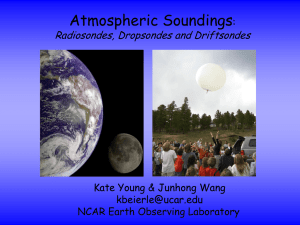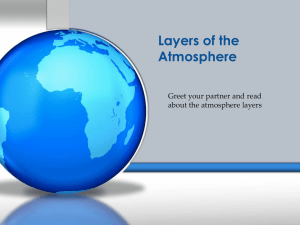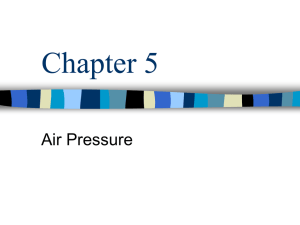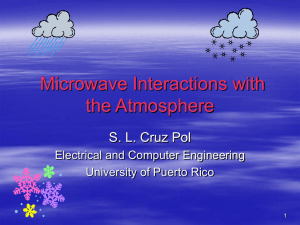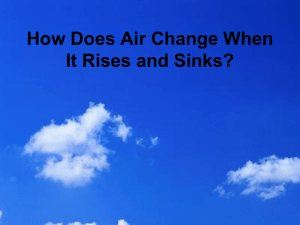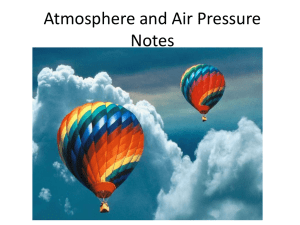Exam 1 - Review - Arizona State University
advertisement
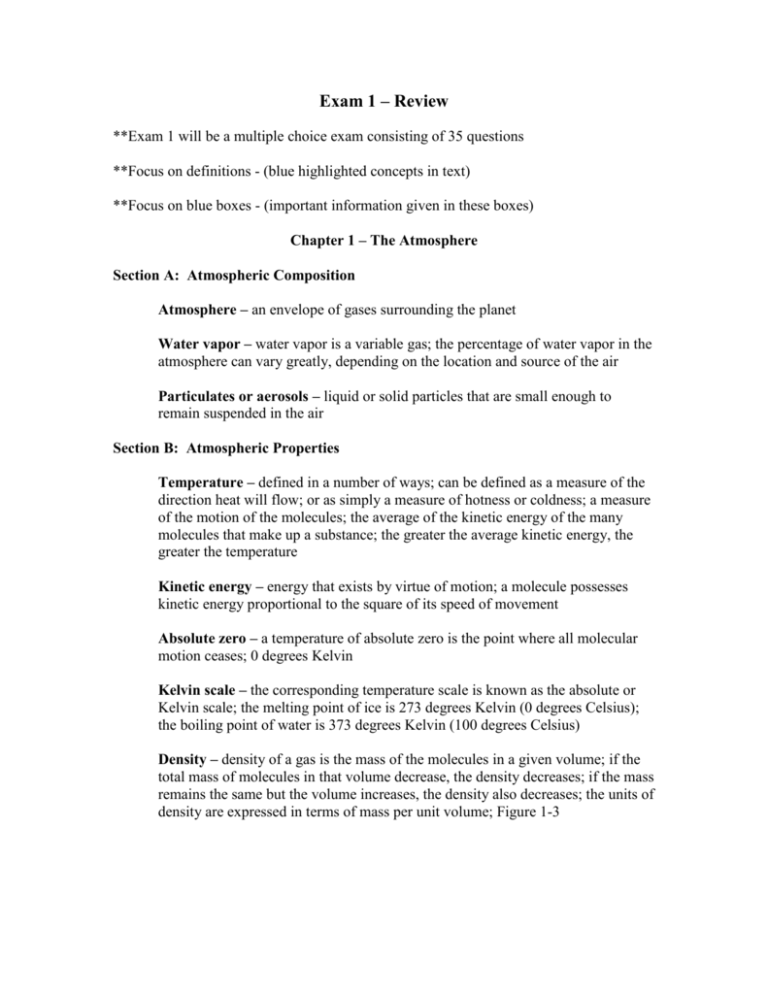
Exam 1 – Review **Exam 1 will be a multiple choice exam consisting of 35 questions **Focus on definitions - (blue highlighted concepts in text) **Focus on blue boxes - (important information given in these boxes) Chapter 1 – The Atmosphere Section A: Atmospheric Composition Atmosphere – an envelope of gases surrounding the planet Water vapor – water vapor is a variable gas; the percentage of water vapor in the atmosphere can vary greatly, depending on the location and source of the air Particulates or aerosols – liquid or solid particles that are small enough to remain suspended in the air Section B: Atmospheric Properties Temperature – defined in a number of ways; can be defined as a measure of the direction heat will flow; or as simply a measure of hotness or coldness; a measure of the motion of the molecules; the average of the kinetic energy of the many molecules that make up a substance; the greater the average kinetic energy, the greater the temperature Kinetic energy – energy that exists by virtue of motion; a molecule possesses kinetic energy proportional to the square of its speed of movement Absolute zero – a temperature of absolute zero is the point where all molecular motion ceases; 0 degrees Kelvin Kelvin scale – the corresponding temperature scale is known as the absolute or Kelvin scale; the melting point of ice is 273 degrees Kelvin (0 degrees Celsius); the boiling point of water is 373 degrees Kelvin (100 degrees Celsius) Density – density of a gas is the mass of the molecules in a given volume; if the total mass of molecules in that volume decrease, the density decreases; if the mass remains the same but the volume increases, the density also decreases; the units of density are expressed in terms of mass per unit volume; Figure 1-3 Pressure – pressure is the force exerted by the moving molecules of the gas on a given area (square inch or square foot); pressure at a point acts equally in all directions; a typical value of atmospheric pressure at sea level is 14.7 pounds per square inch (1013.25 millibars, 29.92 inches of mercury) The Gas Law – a unique characteristic of gases is that they obey a physical principle known as the gas law, which can be written as: P / DT = R P = pressure D = density T = absolute temperature R = constant number which is known from experiment and theory; R = universal gas constant = 8.3145 J/mol K The equation states that the ratio of pressure to the product of density and temperature is always the same; if the pressure changes, then either the density or the temperature or both must also change in order for the ratio to remain constant; Figure 1-4; reduce pressure by cooling, reducing mass or increasing volume; the gas law makes the measurement of the gaseous state of the atmosphere much simpler; if we know any two of the three variables that describe the gas, we can always calculate the third; in practice, we usually measure pressure and temperature and deduce the density from the gas law Section C: Atmospheric Structure Dimensions – we are concerned with the size of the atmosphere and its phenomena; How big? How high? How far? These are common questions asked in regard to atmospheric description; in order to keep distances and altitudes in a meaningful context, it is helpful to have some measuring sticks for reference; some of the most useful are the dimensions of the earth; Figure 1-5; distance from pole to equator = 5,397 nm; 3,438 nm radius; 21,625 nm circumference; Appendix A and units and conversions commonly used in aviation meteorology in the US; page 1-7 Atmospheric Layers Temperature Layers Troposphere – in the lowest layer of the atmosphere, the average temperature decreases with altitude; the great majority of the clouds and weather occurs in the troposphere; trope = turn or change; there are often strong vertical air motions; the stability of the stratosphere and instability of the troposphere are related directly to the variation of temperature with altitude in those layers Tropopause – the top of the troposphere is about 36,000 feet above mean sea level (MSL), in middle latitudes; this upper boundary (a level, not a layer) is known as the tropopause; the temperature often reaches a minimum value at this altitude; the tropopause is a important atmospheric feature for pilots because of its connection to a variety of weather phenomena such as jet streams, clear air turbulence and thunderstorms; the altitude of the tropopause varies with latitude and season; the tropopause is lower near the poles and in winter; it is higher near the equator and in summer Stratosphere – as we move upward from the tropopause to the stratosphere temperature tends to change slowly at first and then increase with altitude; air in the stratosphere is confined to move more or less horizontally in strata or layers; the stability of the stratosphere and instability of the troposphere are related directly to the variation of temperature with altitude in those layers Stratopause – at the top of the stratosphere is the stratopause; it occurs at an altitude of about 160,000 feet MSL; the temperature reaches a maximum value at this height Mesosphere – immediately above the stratopause is the mesosphere, a layer where the temperature again decreases with height; the mesosphere extends to a height of slightly more than 280,000 feet MSL, where the mesopause and the coldest temperatures in the diagram are located; Figure 1-8 Mesopause – located at slightly more than 280,000 feet MSL, where the mesopause and the coldest temperatures are located Thermosphere - the highest layer in the model atmosphere; temperatures generally increase with altitude in this layer; the number of air molecules is so small at these very high levels that an average kinetic energy of the air molecules does not have much meaning; objects in space at such heights have temperatures that are more closely related to radiation gain on the sun-facing side of the object and radiation loss on the opposite side Other Layers Ozone layer – sometimes called the ozonosphere; is found in the lower stratosphere; it is characterized by a relatively high concentration of O3 with maximum concentrations near 80,000 feet MSL; the temperature maximum near the stratopause is due to the absorption of solar radiation by the ozone; Figure 1-8 Ozone hole – region of the ozone layer with lower-than-normal O3 concentration; especially noticeable over the South Pole in spring months (September to December); the ozone hole is created when pollutants, in particular man-made chlorofluorocarbons (CFCs), reach stratospheric levels; solar radiation at those altitudes is intense enough to break the CFCs down so that the chlorine is free to destroy ozone molecules Ionosphere – a deep layer of charged particles (ions and free electrons) that extends from the lower mesosphere upward through the thermosphere; Figure 1-8; the production of charged particles occurs at those altitudes because incoming solar radiation has sufficient energy to strip electrons from atoms and molecules; AM radio waves are reflected and/or absorbed by different sub layers of the ionosphere; radio communications may be greatly influenced by variations in the lower part of the ionosphere at sunrise and sunset and during periods of greater solar activity ***In the lower troposphere, pressure decreases about 1 inch of mercury (about 34 mb) for each thousand feet of altitude gain Standard Atmosphere – the standard atmosphere, also called the international standard atmosphere (ISA), is an idealized atmosphere with specific vertical distributions of pressure, temperature, and density prescribed by international agreement; the standard atmosphere is used for several aerospace applications, such as determining altitude from pressure altimeters; the ISA for the lower stratosphere and troposphere is shown graphically in Figure 1-10 where the majority of aircraft operations take place ***In the ISA troposphere, the temperature decreases 2 degrees Celsius for each 1,000-foot increase in altitude Chapter 2 – Atmospheric Energy and Temperature Section A: Energy Transfer Radiation – the transfer of energy by electromagnetic waves Conduction – the transfer of energy through molecular motion Convection / Advection – refers to the transfer of energy through the movement of mass Solar Radiation Sun-Earth Geometry Equinoxes – at noon on the first days of spring and fall (the equinoxes), the sun’s rays are perpendicular to the earth’s surface at the equator Solstices – On the first day of summer and the first day of winter (the solstices), the noonday sun reaches its highest and lowest latitudes, respectively Solar elevation angle – the influence of the changing position of the sun relative to the earth is illustrated in terms of the solar elevation angle (angle of the sun above the horizon); figure 2-2 Radiation Process Absolute zero – temperature where all molecular motion ceases Solar declination – the latitude where the noon sun is directly Overhead Speed of light – light is one of many types of electromagnetic radiation Infrared (IR) – frequencies lower than red Ultraviolet (UV) – frequencies higher than blue Wavelength – (L) is the distance between two successive, identical wave features, such as two wave crests Amplitude – (A) is half the distance between the lowest and highest points of the wave Frequency – (f) is the number of waves that pass some fixed point in a given time interval; units of frequency are cycles per second (cps) or Hertz (Hz) Spectrum – a useful diagram to illustrate the energy of electromagnetic radiation; a graph of electromagnetic wave energy (A2) for all electromagnetic waves verses their wavelengths; Figure 2-4 Albedo – there is a loss of approximately 30 percent of the incoming solar radiation due to reflection and scattering by clouds and other particulates and reflection from the earth’s surface; this loss is called the albedo of the earth and its atmosphere; Figure 2-5 Terrestrial Radiation Heat capacity – an important control of surface temperature is the heat capacity of the surface (ground or water); in general heat capacity is the amount of heat energy that is necessary to raise the temperature of a substance by a certain amount Greenhouse effect – the capture of terrestrial radiation by certain atmospheric gases is called the greenhouse effect and the gases are called greenhouse gases Conduction – spoon left in a bowl of hot soup; the energetic molecules in the hot end of the spoon transfer their momentum to the molecules in the cool end of the spoon; hotter temperatures are conducted up the handle Convection / Advection – advection includes the north-south movements of large warm and cold air masses; convection includes the large scale ascent and descent of air masses and the smaller scale development of thunderstorms Section B: Temperature Temperature Scales – temperature scales common to aviation are Fahrenheit and Celsius; Figure 2-6 Temperature Measurements – temperature of the air measured at 1.5 meters (about 5 feet) above the ground; measured in a standard instrument shelter in the shade to protect the thermometer from direct solar radiation but allow the free ventilation of outside air; figure 2-7 Upper air temperatures – other common temperatures used in aviation meteorology are those measured in the free atmosphere; that is, above the earth’s surface; such temperatures are usually identified as temperatures aloft, as upper air temperatures, or with reference to the height or pressure level where they are measured Indicated air temperature (IAT) – another aviation-related temperature measurement is IAT which is the temperature of the air as measured by a temperature probe on the outside of an aircraft Outside air temperature (OAT) – also called the true air temperature (TAT); determined by correcting the measured or indicated air temperature for compression and friction heating Sounding – upper air temperatures are usually measured directly with freely rising instrumented balloons or soundings or by aircraft; temperature soundings are also made from weather satellites by relating temperature at various altitudes to measurements of radiant energy emitted from the earth, clouds and various atmospheric gases Global Temperature Distribution Surface Temperatures Temperature gradient – a temperature gradient is defined as the change of temperature divided by the distance over which the change occurs; where the isotherms are close together, gradients are relatively strong (large temperature change over a small distance) Upper Air Temperatures – Figure 2-9; temperatures in degrees Celsius at 500 mb (about 18,000 feet, 5,500 meters MSL) for the Northern Hemisphere; temperatures in degrees Celsius at 100 mb (about 53,000 feet, 16,000 meters MSL) for the Northern Hemisphere; relatively cold and warm regions labeled Chapter 3 – Pressure, Altitude and Density Section A: Atmospheric Pressure – may also be defined as the weight of a column of the atmosphere with a given cross-sectional area; figure 3-1; Atmospheric Pressure = Weight (Force) / Area = 14.7 lbs/1 in sq = 14.7 lbs/in sq Hydrostatic balance – figure 3-2; the balance between the downward-directed gravitational force and an upward-directed force caused by the decrease of atmospheric pressure with altitude is called hydrostatic balance Pressure Measurements Mercurial barometer – one of the most basic devices for the measurement of pressure Aneroid barometer – another pressure instrument, known as the aneroid barometer is more frequently used outside the laboratory; has no liquid; operates on differences in air pressure between the atmosphere and a closed vessel (an aneroid cell); aneroid means “not wet” Figure 3-4 Section B: Charting Atmospheric Pressure Station and Sea Level Pressure – surface pressure measurements are most useful if they can be compared with nearby measurements at the same altitude; over land areas, the direct comparison of station pressures are usually difficult because weather stations are often at different altitudes; Figure 3-5; the atmospheric pressure measured or estimated at an elevation equal to mean sea level; this extrapolated sea level pressure (station pressure corrected for elevation) is used by pilots to determine altitude; also used in aviation reports to depict the atmospheric pressure of a reporting location Sea Level Pressure Patterns Surface analysis charts – a chart which shows pressure as well as other meteorological conditions at the surface of the earth Isobars – lines of constant pressure; figure 3-6 High (H) – location where the sea level pressure is high compared to its surroundings Ridge – an elongated region of relatively high pressure Low (L) – a roughly circular area with a lower sea level pressure in the center as compared to the surrounding region Trough – an elongated region of relatively low pressure; these features are to a surface analysis chart what mountains and valleys are to a topographical chart Pressure gradient – a difference in pressure over a given distance Semi-permanent pressure systems – Bermuda High, Aleutian Low, Siberian High, Icelandic Low, Pacific High ***On a surface analysis chart, the solid lines that depict sea-level pressure patterns are called isobars ***On a surface analysis chart, close spacing of the isobars indicates strong pressure gradient Constant Pressure Charts – a constant pressure surface is one where the pressure is the same at all points; like the ocean’s surface, a constant pressure surface is not necessarily level; many upper air weather charts that you may use are called constant pressure analysis charts or simply constant pressure charts; figure 3-7; the interpretation of a constant pressure chart is identical with the sea level pressure chart as far as highs, lows, troughs, ridges and gradients are concerned; the main difference is one of terms used to describe the elements; on constant pressure surfaces, lines of constant height are called contours rather than isobars; gradients are height gradients rather than pressure gradients; figure 3-8 Pressure Altitude – the altitude of a given pressure surface in the standard atmosphere; figure 3-9; pilots can determine pressure altitude by setting the standard sea level pressure, 29.92 inches Hg in the aircraft altimeter ***Pressure altitude is the altitude indicated when the altimeter setting is 29.92. If you set your altimeter at 29.92 and fly at 18,289 feet indicated altitude, you will be flying along the 500 mb constant pressure surface Section C: The Pressure Altimeter – the altimeter is essentially an aneroid barometer that reads in units of altitude rather than pressure; this is possible by using the standard atmosphere to make the conversion from pressure to altitude; Appendix B; Figure 3-10 Indicated altitude – the altitude measured by your altimeter True altitude – the actual altitude of your aircraft above mean sea level Absolute altitude – the altitude of your aircraft above the ground Altimeter errors – there are three specific altimeter errors caused by nonstandard atmospheric conditions 1. sea level pressure different from 29.92 inches of mercury 2. temperature warmer or colder than standard temperature; atmospheric pressure decreases with altitude more rapidly in cold air than in warm air 3. strong vertical gusts ***Altimeter setting is the value to which the barometric pressure scale on the altimeter is set so the altitude indicates true altitude at field elevation ***On warm days pressure surfaces are raised and the indicated altitude is lower than true altitude Altimeter setting – figure 3-10; variable sea level pressure is usually taken care of by adjusting the altimeter to the proper altimeter setting; this is the sea level pressure determined from the station pressure and the standard atmosphere METARs and Altimeter Settings Aviation Routine Weather Report (METAR) – altimeter settings for airports worldwide are reported and transmitted regularly with other weather information in a standard coded format; these reports are commonly available to pilots; figure 3-13 Type of Report Aviation selected special weather report (SPECI) – the special METAR weather observation is an unscheduled report indicating a significant change in one or more elements Station Designator and Date/Time of Report – each reporting station is listed by its four-letter International Civil Aviation Organization (ICAO) identifier; in the contiguous 48 states, the letter “K” prefixes the three-letter domestic location identifier Modifier – when a METAR is created by a totally automated weather observation station, the modifier AUTO will follow the date/time element; RMK A02 indicates the weather observing equipment used has the capability of distinguishing precipitation type; the modifier COR is used to indicate a corrected METAR which replaces a previously disseminated report; no modifier indicates a manual station or manual input at an automated station Temperature and Dew-point – the current air temperature and dew-point are reported in two-digit form in degrees Celsius and are separated by a slash Altimeter – reported in inches of mercury in a four digit group without the decimal point and is prefixed by an “A” Remarks – the remarks section begins with “RMK;” the remark “SLP134” refers to the sea level pressure of 1013.4 hectoPascals (hPa); the leading 9 or 10 is omitted; prefix the number with a 9 or 10; whichever brings it closer to 1,000.0; a remark such as “T00081016” refers to the temperature and dew point in tenths degrees Celsius; in this example, the first zero in the sequence indicates a plus value for temperature (+.8C) and the leading “one” in the sequence shows a minus value for dew point (-1.6C). Section D: Density – aircraft performance depends critically on atmospheric density ***Pressure altitude and density altitude have the same value at standard temperature in the standard atmosphere Density Altitude – the altitude above mean sea level at which a given atmospheric density occurs in the standard atmosphere; can be interpreted as pressure altitude corrected for non-standard temperature differences; in warmer than standard surface conditions, you would say that the density altitude is “high” that is, operation of your aircraft in a high density altitude condition is equivalent to taking off from a higher airport during standard conditions; in a high density altitude situation, the actual density at the surface is found above the airport elevation in the standard atmosphere; figure 3-14 Chapter 4 – Wind Section A: Wind Terminology and Measurements Wind – horizontal air motions Wind velocity – a vector quantity Vector – a vector quantity has a magnitude and a direction Scalar – temperature and pressure are examples of scalar quantities which only have magnitude Wind speed – the magnitude of the wind velocity usually expressed in nautical miles per hour (knots), statute miles per hour (mph), kilometers per hour, or meters per second Wind direction – the direction from which the wind is blowing, measured in degrees, or to eight or sixteen points of the compass, clockwise from true north (360 degrees) METAR Wind Information Sustained speed – reported wind speeds and directions are usually one or two-minute averages; this average wind speed is also referred to as the sustained speed Peak wind – the maximum instantaneous wind speed greater than 25 knots since the last hourly observation Section B: Causes of Wind – the most important forces that affect air motions are pressure gradient force, coriolis force and frictional force Section C: Pressure Gradient Force – the difference in pressure between two points divided by the distance between the points; the larger the pressure difference, the greater the acceleration through the opening; magnitude of the pressure gradient = (P1 – P2 / distance) Horizontal pressure gradient – the atmosphere causes air parcels to be accelerated across the surface of the earth toward low pressure when a horizontal pressure gradient force exists Causes of Pressure Gradients Differential heating – creation of a horizontal temperature gradient by Differential heating Thermal circulation – in general, the movement of air which results from differential heating; thermal circulations have two horizontal branches; an upper branch which is called the return flow and a lower branch; figure 46 sea breeze Section D: Coriolis Force – a deflective force resulting from earth’s rotation; it acts 90 degrees to the right of wind direction in the Northern Hemisphere and 90 degrees to the left of the wind in the Southern Hemisphere Section E: Geostrophic Balance – Coriolis and pressure gradient forces tend to be equal in magnitude but opposite in direction Geostrophic winds – the related wind is the geostrophic wind; it is quite helpful in understanding the characteristics of wind and it provides a good approximation to the actual wind ***When the isobars on the surface analysis chart are close together, the pressure gradient force is large and wind speeds are strong ***Wind directions can be inferred from isobaric patterns ***Winds do not blow directly from large scale high pressure areas to low-pressure areas because of Coriolis force Estimating Winds from Isobars and Contours ***The 500 mb constant pressure chart is suitable for flight planning at FL 180; observed temperature and wind information give approximate conditions along the proposed route D-Values – the difference between the two (True Altitude (TA) – Pressure Altitude (PA)); the crosstrack geostrophic wind is proportional to the gradient in D-values along the flight track Section F: Friction – the force that resists the relative motion of two bodies in contact Skin friction – friction also occurs within fluids, such as the atmosphere and at the interface between fluids and solids Form drag – caused by turbulence induced by the shape of the aircraft Surface friction – describes the resistive force that arises from a combination of skin friction and turbulence near the earth’s surface Boundary layer – a transition zone between large surface frictional effects near the ground and negligible effects above the boundary layer; figure 4-12 ***Because of the decrease of surface frictional effects with height, the winds at 2,000 feet AGL tend to parallel the isobars. At the surface, winds cross the isobars at an angle toward lower pressure and are weaker than winds aloft ***Wind is caused by pressure differences and modified by the earth’s rotation and surface friction Section G: Other Effects Wind Production by Vertical Motions – see Figure 4-13 Accelerated Airflow Centrifugal force – when air moves along a curved path, even if it is traveling at a constant speed, it is subjected to an acceleration; the direction of motion is constantly changing along the path; this is known as centripetal acceleration; it is due to an imbalance in forces; when discussing this effect, some find it more convenient to refer to a force that produces the centripetal acceleration – the centrifugal acceleration Cyclostrophic balance – coriolis force, the pressure gradient and centrifugal forces may be in cyclostrophic balance and produce cyclostrophic winds; the most dramatic examples of these are dust devils and tornadoes; figure 4-14 Chapter 5 – Vertical Motion and Stability Section A: Vertical Motions – when an air parcel moves from one location to another, it typically has a horizontal component (wind) and a vertical component (vertical motion) Causes – air may move upward or downward for a number of reasons; the most frequent causes are convergence and divergence, orography, fronts and convection Convergence / Divergence Convergence – corresponds to a net inflow of air into a given area; it may occur when wind speed slows down in the direction of flow and/or when opposing airstreams meet; figure 5-2 Divergence – the net outflow from a given area; winds may diverge when the wind speed increases in the direction of the flow and/or when an air stream spreads out in the downstream direction; figure 5-2 ***Embedded thunderstorms are obscured by massive cloud layers and cannot be seen Orography – air can be forced upward or downward when it encounters a barrier; a simple example is orographic lifting; when wind intersects a mountain or hill, it is simply pushed upward; on the down-wind or lee side of the mountain, air moves downward Fronts – when the atmosphere itself creates an obstacle to the wind, a barrier effect similar to a mountain can be produced; when a cold air mass is next to a warm air mass, a narrow, sloping boundary is created between the two called a front Frontal lifting – if either air mass moves toward the other, the warm air moves upward over the cold, dense air mass in a process called frontal lifting or in some special cases overrunning Convection Convective lifting – as bubbles of warm air rise in the convective lifting process, the surrounding air sinks; figure 5-6 and occurs under unstable atmospheric conditions Mechanical Turbulence – Figure 5-7; chaotic eddies are swept along with the wind, producing downward motions on their downwind side and upward motions on their upwind side; rough air experienced when landing on windy days is caused by these small scale circulations Gravity Wave Motions – under certain circumstances, air may be disturbed by small scale wave motions; that is, parcels of air may be caused to oscillate vertically; figure 5-8; such oscillations that move away from the source of the disturbance are called atmospheric gravity waves because the earth’s gravity plays an important role in producing them; a mountain wave is one type of gravity wave Section B: Stability – a stable system may be defined as one that, if displaced or distorted, tends to return to its original location and/or configuration; an unstable system is one that tends to move away from its original position, once it has been displaced or distorted; a system with neutral stability remains in its new position if displaced or distorted; figure 5-9 Atmospheric Stability – a condition that makes it difficult for air parcels to move upward or downward; atmospheric instability is a condition that promotes vertical motions Buoyancy – the property of an object that allows it to float on the surface of a liquid, or ascend through and remain freely suspend in a compressible fluid such as the atmosphere Archimedes’ Principle – when an object is placed in a fluid (liquid or gas), it will be subjected to a positive (upward) or negative (downward) force depending on whether the object weighs more or less than the fluid it displaces; can be thought of as the bowling ball / balsa wood-in-thebucket-of-water concept; figure 5-11 Positively buoyant – if a parcel of air is displaced upward and becomes warmer than its surroundings, it is positively buoyant; it will accelerate upward (away from its original position); it is unstable Negatively buoyant – if a parcel of air is displaced upward and is colder than its surroundings, it is negatively buoyant; it will be accelerated downward (back to its original position); it is stable Determining Atmospheric Stability – there are three basic concepts that help determine stability; the dry adiabatic process, atmospheric soundings and lapse rates Dry adiabatic process – cooling by expansion and warming by Compression Adiabatic cooling – pressure always decreases with height; adiabatic cooling will always accompany upward motion Adiabatic heating – adiabatic heating will always accompany downward motion; the rate of temperature change associated with a dry adiabatic process is a constant: 3 degrees Celsius per 1,000 feet (5.4 degrees Fahrenheit per 1,000 feet) ***Understand (cloud-free) air flowing upslope will cool at the rate of approximately 3 degrees Celsius per 1,000 feet Soundings – a measurement of meteorological conditions between the ground and some higher level in the atmosphere Radiosondes – the most common meteorological soundings are made via freely rising, unmanned, instrumented balloons called radiosondes or rawinsondes Lapse Rates – an important stability measurement that can be determined from a sounding; the change of temperature with altitude for a given atmospheric layer Lapse rate (LR) = T (bottom) – T (Top) / DELZ T (bottom) = temperature at the bottom of the layer T (top) = temperature at the top of the layer DELZ = thickness of the layer Dry adiabatic lapse rate (DALR) – the rate at which the temperature of a dry parcel of air decreases as it ascends is also a useful reference in stability determinations; equal to 3 degrees C per 1,000 feet; figure 5-14 Isothermal layer – no change in temperature with height (LR = 0) Inversion layers – temperature increases with height (LR < 0) Surface-based inversions – often form at night and may be the source of wind shear problems Stability Evaluation Stability criteria; figure 5-15; figure 5-16; figure 5-17 1. select the layer in the sounding in which you are interested 2. within the layer, compare the actual LR and DALR 3. determine which of the following stability criteria are satisfied LR > DALR – absolutely unstable LR = DALR – neutral LR < DALR – stable Section C: Stability and Vertical Motions ***A stable air mass is more likely to have smoother air than an unstable air mass ***The formation of either predominantly stratiform or predominately cumuliform clouds depends upon the stability of the air being lifted ***Conditions favorable for the formation of a surface-based temperature inversion are clear, cool nights with calm or light winds ***The stability of an air mass is decreased by heating it from below Chapter 6 – Atmospheric Moisture Section A: Moisture Characteristics State Changes Water vapor – is a colorless, odorless, tastless gas in which the molecules are free to move about, as in any gas Water – in the liquid state (water), molecules are restricted in their movements in comparison to water vapor at the same temperature Ice – as a solid ice, the molecular structure is even more rigid and the freedom of movement is greatly restricted Change of state – refers to the transition from one form of H2O to another ***The processes by which water vapor is added to unsaturated air are evaporation and sublimation Melting – ice to water Evaporation – water to vapor Sublimation – ice directly to vapor without water as an intermediate state; figure 6-1 Condensation – vapor to water Freezing – water to ice Deposition – vapor directly to ice without water as an intermediate state Latent heat – the amount of heat energy that is absorbed or released when H2O changes from one state to another Sensible heat – heat that can be felt and measured when the molecules pass to lower energy states Vapor Pressure Partial pressure – in the mixture of atmospheric gases, each individual gas exerts a partial pressure Vapor pressure (VP) – the partial pressure exerted by water vapor (H2O in gaseous form) Saturation – occurs when the same amount of molecules are leaving a water surface as are returning Saturation vapor pressure (SVP) – figure 6-2; the vapor pressure exerted by the molecules of water vapor in this equilibrium condition ***The amount of water vapor needed to saturate the air largely depends on air temperature Boiling – occurs when SVP equals the total air pressure Relative Humidity – it is often useful to determine how close the atmosphere is to saturation; this information can help you anticipate the formation of clouds or fog; this is done by measuring the amount of water vapor in the atmosphere in terms of actual VP and then estimating SVP from a temperature measurement; figure 6-3; the degree of saturation is then computed by taking the ratio of VP and SVP and multiplying it by 100; the result is called relative humidity; it expresses the amount of water vapor actually in the air as a percentage of the amount required for saturation RH (%) = (VP/SVP) x 100 Dewpoint Temperature Dewpoint – the temperature at which condensation first occurs when air is cooled at a constant pressure without adding or removing water vapor; dew point temperature is always less than the air temperature, with one exception; when the air is saturated (RH = 100%), the temperature and dew point are equal ***Dew point refers to the temperature to which air must be cooled to become saturated Temperature-Dew point Spread – a very useful quantity that relates RH and dew point; also called the dew point depression; it is the difference between the air temperature and dew point; when the temperature-dew point spread is small, the RH is high; when the spread is very large, the RH is low; figure 6-4 Dew – a condensation product that forms when the ground or other object (such as the wings of a parked airplane) loses heat energy through night time (nocturnal) radiation White dew – if the temperature falls below 32 degrees F (0 degrees C) after dew is present, it will freeze ***Frost forms when the temperature of the collecting surface is at or below the dew point of the adjacent air and the dew point is below freezing. Frost is considered hazardous to flight because it spoils the smooth flow of air over the wings, thereby decreasing lifting capability Section B: Clouds - suspension of water droplets and / or ice crystals in the atmosphere Cloud Formation - three requirements for cloud formation are water vapor, condensation nuclei and cooling Water Vapor - cloud development requires adequate water vapor; cloud formation favored in air with high RH (small temperature dew point spread) Condensation Nuclei - - Condensation Nuclei – microscopic particles such as dust and salt that provide surfaces on which water vapor undergoes condensation to form water droplets or deposition to form ice crystals; fog is usually more prevalent in industrial areas because of an abundance of condensation nuclei ***Fog is usually more prevalent in industrial areas because of an abundance of condensation nuclei from combustion Cooling -contact cooling, advection fog often forms in coastal areas; conditions favorable for the formation of radiation fog over a land surface are clear skies, little or no wind, and a small temperature-dew point spread; if the fog is very shallow (less than 20 feet deep) it is called ground fog; valley fog forms when radiational cooling causes cool dense air to pool in a valley; river valleys with ample supplied of moisture are favorable locations for this type of fog; rain shadow; upslope fog; the types of fog that depend on wind in order to exist are advection fog and upslope fog; steam fog is common over unfrozen water bodies in the cold months of the year ***Advection fog often forms in coastal areas ***Conditions favorable for the formation of radiation fog over a land surface are clear skies, little or no wind and a small temperature-dew point spread ***The types of fog that depend upon wind in order to exist are advection fog and upslope fog Latent Heat and Stability -saturated adiabatic process; saturated adiabatic lapse rate (SALR); varies between 3C per 1,000 ft for very cold temperatures and 1C per 1,000 ft for very hot temperatures; condensation level; conditional instability – air parcel must become saturated in order to be unstable Cloud and Visibility Observations -learning to observe clouds and visibility is essential for proper interpretation of METAR and for flight safety Standard Cloud Observations - sky condition – cloud height, cloud amount, cloud type Visibility - tower visibility; prevailing visibility; runway visibility (RVV); runway visual range (RVR); VFR conditions; VFR: ceiling > 3,000 ft AGL and visibility > 5 sm; MVFR: ceiling 1,000 to 3,000 ft AGL and / or visibility 3 to 5 sm; IFR conditions; IFR: ceiling 500 to < 1,000 ft AGL and/or visibility 1 to < 3 sm; LIFR: ceiling <500 feet AGL and / or visibility < 1 sm ***A ceiling is defined as the height above the earth’s surface of the lowest layer reported as broken or overcast, or as the vertical visibility into an indefinite ceiling Cloud Type - ten basic cloud types < 6500 feet AGL low (ST) Stratus, (SC) Stratocumulus, (NS) Nimbostratus; 6,500 to 20,000 ft AGL; Middle (AC) Altocumulus, (AS) Altostratus, High > 20,000 ft AGL (CC) Cirrocumulus, (CS) Cirrostratus, (CI) Cirrus; Clouds with vertical development (CU) Cumulus, (CB) Cumulonimbus; the four families of clouds are high, middle, low and those with extensive vertical development; a high cloud is composed mostly of ice crystals; the stability of the air before lifting occurs determines the structure or type of clouds which form as a result of air being forced to ascend; heights of cumulus cloud bases can be determined by H = (T – DP) / 4.4; Cloud Height – cloud layer, cloud height; fog; vertical visibility (VV) or indefinite ceiling is the vertical distance that an observer or remote sensing device on the ground can see into a low cloud or other obscuring phenomenon; cloud height is the height of the base of the cloud above the ground; when sky is completely obscured the reported cloud height is actually the vertical visibility; Cloud Amount – amount of sky covered by each cloud layer; celestial dome; clear (SKC) – no clouds present; clear (CLR) – no clouds below 12,000 ft AGL; few (FEW) – 1/8 to 2/8 sky cover; scattered (SCT) – 3/8 to 4/8 coverage; broken (BKN) – 5/8 to 7/8 coverage; overcast (OVC) – 8/8 coverage; Obscurations and ceilings – obscuration, ceiling, indefinite ceiling, vertical visibility; a ceiling is defined as the height above the earth’s surface of the lowest layer reported as broken or overcast, or as the vertical visibility into an indefinite ceiling; PIREPS pilot’s reports; ***The four families of clouds are high, middle, low and those with extensive vertical development ***A high cloud is composed mostly of ice crystals ***The stability of the air before lifting occurs determines the structure or type of clouds which form as a result of air being forced to ascend Other Useful Cloud Observations - satellite images from the Geostationary Orbiting Environmental Satellite (GOES) Section C: Precipitation Precipitation Causes - condensation / deposition; collision / coalescence – large droplets fall faster than smaller particles capturing them as they descend; ice crystal process; super cooled water droplets are primary cause of aircraft icing; ice crystals grow at the expense of super cooled water droplets in the ice crystal process Precipitation Characteristics Types - drizzle; rain; rain showers; freezing drizzle; freezing rain; black ice; the presence of ice pellets at the surface is evidence that there may be freezing rain at a higher altitude; ice pellets; snow; snow showers; virga; fall streaks ***The presence of ice pellets at the surface is evidence that there may be freezing rain at a higher altitude Intensity and Amount - drizzle or snowfall intensity and associated visibility; light > ½; moderate > ¼ but < or = 1/2; Heavy < or = ¼; snow depth; heavy snow warning; blizzard METAR - METAR format; Figure 6-27 page 6-27; Visibility – reported in statute miles; Present Weather – intensity symbols light (-); moderate (no sign); or heavy (+), proximity, descriptor; see Figure 6-28 page 6-28; list of contractions for various weather phenomena; see Figure 6-29 page 6-29 Hydrologic Cycle - on and below the surface of the earth, moisture is stored as ice and snow, and as water in lakes, rivers, ground water and the oceans; water vapor removed from the earth’s surface may be transported far from its source by the wind; clouds form and produce precipitation that returns the moisture to the earth’s surface. This chapter discussed water and its three states in the atmosphere; changes of state and the associated latent heat exchanges have important effects on cloud formation and dissipation and on atmospheric stability; there are important differences between the way clouds are formed and the process by which precipitation is produced; it is important for pilots to know the basic elements of cloud and precipitation observing and reporting; pilots should have the ability to recognize the 10 basic cloud types and the types and characteristics of precipitation; this ability will give pilots valuable observational tools which will help evaluate the state of the atmosphere and its likely effects on flight; you know have the knowledge to understand atmospheric storms and circulation structures and future behavior in the next section.

